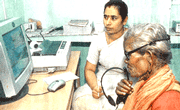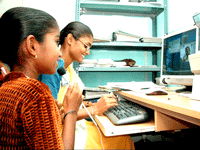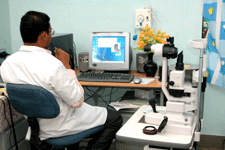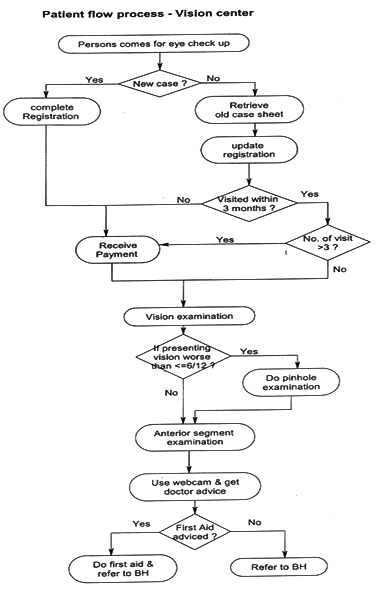
Dear Readers,
The goal of Vision 2020 is to eliminate needless blindness by the year 2020. The role played by Vision Centre in achieving this target by providing primary eye care in the community therefore assumes significant importance. But as this concept takes shape there are questions related to the kind of activities a Vision Centre should perform, the different types of human resources required and the kind of training they should undergo before they can be posted in the Vision Centre,and the kinds of instruments and equipments required in the Vision Centre.
The Vision Centre is very often established and run by a secondary or tertiary eye care facility. The challenges faced by the centre include the need to make it a financially sustainable venture and set up a management information system to monitor its functioning and the ways to market its facilties to ensure its optimum use.
In this issue, we present case studies that capture patients experience at the Vision Centre, different models of Vision Centres, each with their own unique characteristics, and different web resources related to Vision Centres. Do write in to us with your experience related to Vision Centres (eyesite@aravind.org).
Wishing you a Merry Christmas and Happy New Year!
Wish you a productive reading!
Happy reading!
Regards,
Vision 2020 e-resource team
|
|
|
Vision2020 has developed certain policies for Vision Centre:

- Mapping of area served by each Vision Centre to avoid duplication of effort and to ensure co-operation between Govt., NGOs and local community.
- It is important to have a link with a Secondary level eye care facility in Govt., NGO or private sector. A Vision Centre should be set up after the formal establishment of this link.
- The secondary level facility should be present ideally within a radius of 50 km.
- Transport of referred patients to secondary facility should be the responsibility of the latter.
- Complete free service is only for the very economically disadvantaged.
- Nominal registration fee may be charged.
- Referred patients may pay as per the policy of the secondary facility.
- School screening/teachers training should be free, but referred patients may be charged except poor children. Spects will be provided free of cost by DBCS.
- MLOPs should work for 8 hours/day and should be given a fixed salary as per minimum wage of Govt of India plus incentive.
- CONFERENCE ON PRIMARY EYE CARE IN INDIA
Abstract:
A conference on Primary Eye Care workshop was held at Coimbatore from 11th-14th April 2002 to discuss important issues and problems relating to Primary Eye Care. The main objective of the Conference was to develop effective strategies for Primary Eye Care in India.
- REPORT ON VISION CENTRES WORKSHOP
Abstract:
This is a report on the National workshop on "Vision Centre" held at the H.V. Desai Eye Hospital, India on 21st and 22nd December 2004.
|
|
Outreach services such as screening camps are considered to be the most successful community based service delivery model for eye care services. However the utilization of eye care services remains poor. Primarily due to poor accessibility and lack of awareness therefore becomes necessary to be proactive in creating access for eye care services in rural areas. So an alternate model Vision Centre was started, with the main objective of creating permanent access to the rural communities to increase the uptake for eye care services.
 
- NEED FOR VISION CENTRES
Abstract:
This article focuses on the Need for Vision Centres in the current scenario.
- VISION CENTRE
Abstract:
This article focuses on need for Vision Centre, Vision Centre model, its infrastructure.
|
|
Vision Centre should ideally be staffed with three members: a Mid-level Ophthalmic personnel, administrative staff and a community worker.
Mid-level Ophthalmic personnel has to perform refraction, takes care of medication, slit lamp, counsel the patient about the importance of the eye problem and optical dispensing.
Administrative staff should take care of patient flow, computer/telephone operation, maintain statistics, and prescribes glass and maintains information.
Community worker He/She will work closely with other health care personnel, link workers, teachers, leaders, Anganwadis of Integrated Child Development System (ICDS). He/She is engaged in surveillance and does enumeration should train volunteers who does field work. He/She should also coordinate with other Vision Centres.
Training and clear Job description is very essential for Vision Centre workers to perform their job in best way. We have provided you with the training schedule and Job description for various cadres working in Vision Centre. This article would benefit the HR team in training the Vision Centre staff effectively.
|
|
For each Vision Centre, one large room and two small rooms will be required. The large room is for registration and patient waiting hall, one of the small rooms is for refraction and another room for tele consultation purpose. If an additional room is available it can be used to keep records, drugs and optical grinding machine.
The Infrastructure and Equipment required for setting up Vision Centre can be mainly classified into Ophthalmic Equipment, Medical apparatus, Refraction unit, Communication devices, Optical dispensing, Furniture and Fixtures. We have provided you the list of Infrastructure and Equipment needed to setup Vision Centre.
|
|
One of the biggest issue for Vision Centre is, it is financially not self sustainable. The challenge lies in making it financially sustainable and gradually withdrawing the support to these centres. The main source of income is from sale of spectacles, OPD charges.
|
|
The activities of Vision Centre can be broadly divided into Vision Centre activities, base hospital activities and activities of community worker. The main activities of Vision Centre are active screening services, first Aid services, referral services, health Education, follow up & compliance, population based surveillance system, training programmes, School screening programme and report generation. We have provided you an article which focuses on the various activities of Vision Centre in detail.

- VISION CENTRE ACTIVITIES
Abstract:
This article focuses on the various activities to be followed in Vision Centre.
- VISION CENTRE BROCHURE
Abstract:
This brochure contains objective, functions, benefits, working hours and various other details of a Vision Centre.
|
|
Monitoring the Vision Centre regularly helps to understand the track of its movement, deviation and correction. Recording of activities and achievements aids in planning, implementing and improve further. Monitoring also will give feedback about the progress of the Vision Centre to the implementers and beneficiaries.
- PERFORMANCE INDICATOR OF VISION CENTRES
Abstract:
Performance indicator is a metric or fact that provides insight into a performance to enable assessment and improvement of the existing Vision Centres. Here are the performance indicators which helps to manage the schedule, plan, evaluate the effectiveness and efficiency of the Vision Centres and track the eye care service delivery.
- QUALITY ASSURANCE IN VISION CENTRE
Abstract:
This article focuses on how to maintain the Quality in Vision Centre.
|
|
There is no specific model for Vision Centre, various organizations use different methods. In order to know the various methods a survey was made with the main intension of knowing the various models also this will be useful for others who are planning to start Vision Centres. The models of below mentioned Hospitals are given.
- Aravind Eye Hospital, Theni
- R.R.Lions Eye Hospital, Palakol
- Sadguru Netra Chikitsalaya, Chitrakoot
- Sewa Rural Hospital, Bharuch
- Vivekananda Mission Ashram, Chaitanyapur
- VISION CENTRE MODEL
- LVPEI VISION CENTRE
Abstract:
This article contains the background, Need and Infrastructure required for starting a Vision Centre.
- CAN WE IMPROVE THE EYE HEALTH SEEKING BEHAVIOUR OF THE COMMUNITY? A REALITY WITH VISION CENTRES
Abstract:
Sadhguru Nethra chikitsalaya, Chitrakoot shares about the experience and activities of their Vision Centre.
|
|
Patient's views may be a good way of finding out about the actual use of Vision Centre. So we collected some of the views of the patients and case study was documented. Case studies here describe about the experience of the patients.
- ALL THE WAY FROM CHENNAI
Abstract:
This case study describes about a patient who came all the way from Chennai and how she was benefited by Vision Centre.
- COMPLETE COMPLACENCE
Abstract:
This case study shared the experience of Jeevarathinam retired teacher in Andipatti about Vision Centre and its services.
- SERVICE AT THE DOOR STEP
Abstract:
This case study is the experience of Shantha a house wife staying in the first floor of Vision Centre about Vision Centre.
|
|
Lumbini Eye Hospital
For the people of Nepal, Lumbini Eye Hospital changed the national perception of eye care and brings hope where there once was none. Among developing nations around the world, Lumbini is a model that demonstrates how an eye care institution can both serve the poor in large numbers and be self-supporting.
Lumbini became the first rural eye hospital in a developing country to be financially self-suffuicient. Lumbini demonstrate that even in a poor area, a health care facility could both serve the indigent and pay for itself. This revolutionized the concept of a charity hospital.
Surgical eye camps and village screening programs were held in rural regions, reaching people at greatest risk of blindness. Health educators made special efforts to bridge barriers to women seeking care and to teach Nepali families how to prevent blindness in their children.
Lumbini Eye Hospital,
Siddhartha Nagar,
Bhairahawa,
Nepal
Tel: +977 71 20265/20668.
|
|
 | Archives |
|